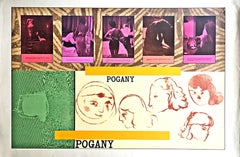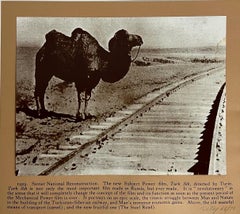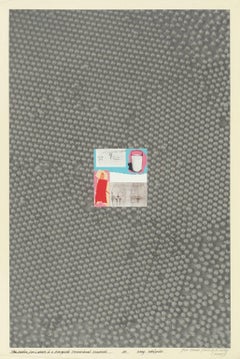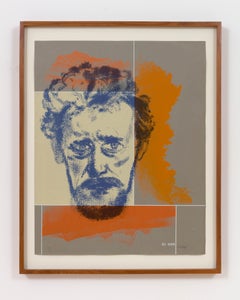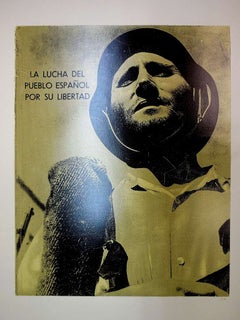Ronald Brooks Kitaj Art
American, 1932-2007
Born in Cleveland, Ohio in 1932, R.B. (Ronald Brooks) Kitaj is considered a key figure in European and American contemporary painting. While his work has been considered controversial, he is regarded as a master draftsman with a commitment to figurative art. His highly personal paintings and drawings reflect his deep interest in history; cultural, social and political ideologies; and issues of identity.
Among his various honors are election to the American Academy of Arts and Letters in 1982, and election to the Royal Academy in 1985 (the first American since John Singer Sargent to receive this honor.)
Numerous retrospective exhibitions of his work include shows at the Hirshhorn Museum in Washington, D.C.; The Jewish Museum, Berlin; The Jewish Museum, London; and the Hamburger Kunsthalle in Germany.
Raised in Cleveland, Ohio, and Troy, New York, Kitaj joined the Merchant Marines in 1949.
In 1950, between sailings, he attended classes at the Cooper Union for the Advancement of Science and Art in New York. He went on to study drawing at the Academy of Fine Art in Vienna, Austria.
Kitaj moved to Oxford, England in 1957, and enrolled at The Ruskin School of Drawing and Fine Art, University of Oxford.
In 1959, Kitaj was accepted into Royal College of Art, London, where he befriended classmate David Hockney. Upon graduation from the RCA, Kitaj signed with Marlborough Fine Art, London, where he had his first solo exhibition in 1963. His art career began in earnest, and he found critical acclaim alongside commercial success.
A second solo show followed at Marlborough Gallery, New York, in 1965, and he sold “The Ohio Gang” to The Museum of Modern Art.
In 1969, Kitaj taught for a year at the University of California, Los Angeles.
In 1976, he coined the term “School of London” in an essay he wrote as curator of the polemical exhibition, “The Human Clay,” at the Hayward Gallery, London. The term, though loose, continues to define a group of stylistically diverse artists, including Kitaj, who were working in London at that time focusing on figural representation.
In 1981, he spent a year in Paris, France, where he focused on drawing and use of pastel.
In 1994, the Tate Gallery, London, organized a major retrospective of Kitaj’s work. Hostile and personal attacks from some critics led to what Kitaj referred to as the “Tate War.” The exhibition subsequently traveled to the Los Angeles County Museum of Art and the Metropolitan Museum of Art, New York.
Kitaj moved to Los Angeles, California, and continued to exhibit with Marlborough Fine Art and the Marlborough Gallery, New York.
In 2001 the National Gallery London organized a solo exhibition of paintings: “R.B. Kitaj In the Aura of Cezanne and Other Masters.” Kitaj focused on his “late style” in his Yellow Studio in Westwood and died in 2007.
His gift of his archive to the UCLA Library Special Collections was celebrated with exhibitions at the Skirball Cultural Center and UCLA’s Young Research Library.(Biography provided by Rosenbaum Contemporary)
to
7
1
5
2
1
1
2
3
Overall Height
to
Overall Width
to
6
2
2
2
2
2
1
1
1
1
1
1
1
1
1
26
7
10
2
2
27
2,180
610
423
356
7
1
Period: 1960s
Artist: Ronald Brooks Kitaj
R.B. Kitaj "The Jerwish Question"
By Ronald Brooks Kitaj
Located in Surfside, FL
Initialled signed in pencil From R. B. Kitaj, In Our Time: Covers for a Small Library After the Life for the Most Part, screenprint 1969 edition of 150 photo screenprint. A cover of the infamous Henry Ford book from the Dearborn Independent "The Jewish Question".
Printed by Kelpra Studio, London, published by Marlborough AG, Schellenberg, Florida. The Jewish Museum. a cover related to Russian Soviet cinema and film.
Stylistically, these are hybrid works, influenced by Pop art and the modernist tradition of the Readymade, a work of art created when a mundane found object is named as an artwork and set in an art context. This avant-garde concept was originally invented by the Dada master Marcel Duchamp early in the twentieth century. In the 1960s it received renewed attention at a time when artistic norms were again being questioned. Reacting to Andy Warhol’s Pop imagery, Kitaj poignantly called his repurposed book covers “his soup can, his Liz Taylor.” The blatant use of images taken directly from commercial sources situates In Our Time as a precursor of appropriation art. In turning book covers into works of art, Kitaj is offering fragments of a history of knowledge, in which the content of each volume is at once mysterious and absent. Coming from this passionate bibliophile, the series is nothing less than an intellectual self-portrait.
R.B. Kitaj, in full Ronald Brooks Kitaj . Ron Kitaj...
Category
1960s Pop Art Ronald Brooks Kitaj Art
Materials
Screen
POGANY rare 17 color 1960s British Pop silkscreen signed numbered edition of 70
By Ronald Brooks Kitaj
Located in New York, NY
R.B. Kitaj
POGANY, 1966
17 colour Screenprint and Photo-screenprint
24 × 36 inches
Pencil signed and numbered from the Limited Edition of 70
Hand-signed by artist, Signed & numbered ...
Category
1960s Pop Art Ronald Brooks Kitaj Art
Materials
Screen, Pencil
R.B. Kitaj Screenprint Collage Hand Signed British Pop Art Film Still Camel
By Ronald Brooks Kitaj
Located in Surfside, FL
The Most Important Film Ever Made, 1972
Color screen print and collage, from the edition of 70.
15 x 17 in
38.1 x 43.2 cm
Published by the artist with Marlborough Graphics at the Kelpra studio in 1972. This work is also in the collections of TATE London and the Victoria & Albert Museum. the price reflects the fact that there is no backing page.
Stylistically, these are hybrid works, influenced by Pop art and the modernist tradition of the Readymade, a work of art created when a mundane found object is named as an artwork and set in an art context. This avant-garde concept was originally invented by the Dada master Marcel Duchamp early in the twentieth century. In the 1960s it received renewed attention at a time when artistic norms were again being questioned. Reacting to Andy Warhol’s Pop imagery, Kitaj poignantly called his repurposed lithograph and silkscreen book covers “his soup can, his Liz Taylor.” The blatant use of images taken directly from commercial sources situates In Our Time as a precursor of appropriation art. In turning book covers into works of art, Kitaj is offering fragments of a history of knowledge, in which the content of each volume is at once mysterious and absent. Coming from this passionate bibliophile, the series is nothing less than an intellectual self-portrait.
R.B. Kitaj, in full Ronald Brooks Kitaj . Ron Kitaj...
Category
1960s Pop Art Ronald Brooks Kitaj Art
Materials
Screen
The Flood of Laymen
By Ronald Brooks Kitaj
Located in New York, NY
screenprint, edition of 70
Category
1960s Pop Art Ronald Brooks Kitaj Art
Materials
Screen
The Desire for Lunch is a Bourgeois Obsessional Neurosis or Grey Schizoids
By Ronald Brooks Kitaj
Located in New York, NY
12 color screenprint, photo-screenprint on buff Hodomuragami paper
edition of 70
Category
1960s Pop Art Ronald Brooks Kitaj Art
Materials
Screen
Ed Dorn
By Ronald Brooks Kitaj
Located in New York, NY
color silkscreen, edition of 70
Category
1960s Pop Art Ronald Brooks Kitaj Art
Materials
Screen
Acheson Go Home
By Ronald Brooks Kitaj
Located in New York, NY
This piece is a color silkscreen, constructed from various pieces of propaganda that Kitaj encountered while studying in Vienna in 1951. It also includes photographs of Kitaj himself...
Category
1960s Ronald Brooks Kitaj Art
Materials
Screen
Related Items
"Moi je veux vivre monotone" by Patrick Caulfield, Screenprint, Pop Art, Purple
By Patrick Caulfield
Located in Köln, DE
"Moi je veux vivre monotone" is from the series "Some poems by Jules Laforgue". Patrick Caulfied was deeply inspired by these poems and found to his very own depiction of these poems...
Category
1970s Pop Art Ronald Brooks Kitaj Art
Materials
Screen
Kansei (2010). Limited Edition (print) by Takashi Murakami signed, numbered
By Takashi Murakami
Located in Hong Kong, HK
Kansei: Like The River's Flow
2010 by Takashi Murakami
Offset print, cold stamp and high gloss varnishing with silver ink
signed, numbered and stamped by the Artist
27 7/8 in diamete...
Category
Early 2000s Pop Art Ronald Brooks Kitaj Art
Materials
Offset
Rose Tinted , still life, heart balloon, wall art
Located in Deddington, GB
• 80 x 100cm A study in Rose Gold, painstakingly drawn in Jack's hyper-realism style with coloured pencil, and printed on museum quality 100% cotton paper. Set on a dramatic black background. 'Rose-Tinted' is a limited edition giclée print of a pencil drawing, and is hand signed and numbered by the artist. This heart balloon...
Category
2010s Pop Art Ronald Brooks Kitaj Art
Materials
Giclée
Three Deer, Pop Art Screenprint by Hunt Slonem
By Hunt Slonem
Located in Long Island City, NY
Artist: Hunt Slonem, American (1951 - )
Title: Three Deer
Year: 1980
Medium: Screenprint, signed and numbered in pencil
Edition: AP 30
Image Size: 24 x 32 inches
Size: 26 in. ...
Category
1980s Pop Art Ronald Brooks Kitaj Art
Materials
Screen
Heartburn, pop art, still life, heart balloon, wall art, red heart
Located in Deddington, GB
• 80 x 100cm A study in red, painstakingly drawn in Jack's hyper-realism style with coloured pencil, and printed on museum quality 100% cotton paper. 'Heartburn' is a limited edition...
Category
2010s Pop Art Ronald Brooks Kitaj Art
Materials
Giclée
H 39.38 in W 31.5 in D 0.4 in
Montreux Jazz Festival 1983 (Green)
By Keith Haring
Located in London, GB
Title: Montreux Jazz Festival 1983 by Keith Haring 1986
Medium: Screenprint in colours on half-matte coated 250 gr paper
Printer: Albin Uldry
Size: 70 x 100 cm (27.6 x 39.4 in)
S...
Category
1980s Pop Art Ronald Brooks Kitaj Art
Materials
Screen
Paint Cans
By Wayne Thiebaud
Located in Palm Desert, CA
"Paint Cans" is a lithograph in colors on wove paper made in 1990 by Wayne Thiebaud. The work is number 13 from an edition of 100. The work is signed in pencil, lower right, "Thiebau...
Category
Late 20th Century Pop Art Ronald Brooks Kitaj Art
Materials
Lithograph
Kent State, by Richard Hamilton political protest Pop art screen print
By Richard Hamilton
Located in New York, NY
Richard Hamilton describes the genesis and printing of Kent State: “It had been on my mind that there might be a subject staring me in the face from the TV ...
Category
1970s Pop Art Ronald Brooks Kitaj Art
Materials
Screen
Vibrant 1975 Joe Tilson British Pop Art Screenprint, Woodblock, Colorful Print
By Joe Tilson
Located in Surfside, FL
Silkscreen screenprint. Hand signed and numbered. A pyramid or ziggurat in vibrant colors of blue, red, yellow, orange and green on heavy paper
Joseph Charles Tilson RA (born 24 Au...
Category
1970s Pop Art Ronald Brooks Kitaj Art
Materials
Screen
Judy Rifka Abstract Expressionist Contemporary Lithograph Hebrew 10 Commandment
By Judy Rifka
Located in Surfside, FL
Judy Rifka (American, b. 1945)
44/84 Lithograph on paper titled "Thou Shalt Not Bear False Witness against Thy Neighbor"; Depicting an abstract composition in blue, green, red and black tones with Hebrew script. Judaica interest. (I have seen this print described as a screenprint and as a lithograph)
Hand signed in pencil and dated alongside an embossed pictorial blindstamp of a closed hand with one raised index finger. Solo Press.
From The Ten Commandments Kenny Scharf; Joseph Nechvatal; Gretchen Bender; April Gornik; Robert Kushner; Nancy Spero; Vito Acconci; Jane Dickson; Judy Rifka; Richard Bosman and Lisa Liebmann.
Judy Rifka (born 1945) is an American woman artist active since the 1970s as a painter and video artist. She works heavily in New York City's Tribeca and Lower East Side and has associated with movements coming out of the area in the 1970s and 1980s such as Colab and the East Village, Manhattan art scene. A video artist, book artist and abstract painter, Rifka is a multi-faceted artist who has worked in a variety of media in addition to her painting and printmaking. She was born in 1945 in New York City and studied art at Hunter College, the New York Studio School and the Skowhegan School of Painting and Sculpture in Maine.
Rifka took part in the 1980 Times Square Show, (Organized by Collaborative Projects, Inc. in 1980 at what was once a massage parlor, with now-famous participants such as Jenny Holzer, Nan Goldin, Keith Haring, Kenny Scharf, Jean-Michel Basquiat, and Kiki Smith, the roster of the exhibition reads like a who’s who of the art world), two Whitney Museum Biennials (1975, 1983), Documenta 7, Just Another Asshole (1981), curated by Carlo McCormick and received the cover of Art in America in 1984 for her series, "Architecture," which employed the three-dimensional stretchers that she adopted in exhibitions dating to 1982; in a 1985 review in the New York Times, Vivien Raynor noted Rifka's shift to large paintings of the female nude, which also employed the three-dimensional stretchers. In a 1985 episode of Miami Vice, Bianca Jagger played a character attacked in front of Rifka's three-dimensional nude still-life, "Bacchanaal", which was on display at the Museum of Art Fort Lauderdale. Rene Ricard wrote about Rifka in his influential December 1987 Art Forum article about the iconic identity of artists from Van Gogh to Jean-Michel Basquiat and Keith Haring, The Radiant Child.The untitled acrylic painting on plywood, in the collection of the Honolulu Museum of Art, demonstrates the artist's use of plywood as a substrate for painting. Artist and writer Mark Bloch called her work "imaginative surfaces that support experimental laboratories for interferences in sensuous pigment." According to artist and curator Greg de la Haba, Judy Rifka's irregular polygons on plywood "are among the most important paintings of the decade".
In 2013, Rifka's daily posts on Facebook garnered a large social media audience for her imaginative "selfies," erudite friendly comments, and widely attended solo and group exhibitions, Judy Rifka's pop art figuration is noted for its nervous line and frenetic pace. In the January 1998 issue of Art in America, Vincent Carducci echoed Masheck, “Rifka reworks the neo-classical and the pop, setting all sources in quotation for today’s art-world cognoscenti.” Rifka, along with artists like David Wojnarowicz, helped to take Pop sensibility into a milieu that incorporated politics and high art into Postmodernism; Robert Pincus-Witten stated in his 1988 essay, Corinthian Crackerjacks & Passing Go that "Rifka’s commitment to process and discovery, doctrine with Abstract Expressionist practice, is of paramount concern though there is nothing dogmatic or pious about Rifka’s use of method. Playful rapidity and delight in discovery is everywhere evident in her painting." In 2016, a large retrospective of Rifka's art was shown at the Jean-Paul Najar Foundation in Dubai. In 2017, Gregory de la Haba presented a Rifka retrospective at the Amstel Gallery in The Yard, a section of Manhattan described as "a labyrinth of small cubicles, conference rooms and small office spaces that are rented out to young entrepreneurs, professionals and hipsters". In 2019 her video Bubble Dancers New Space Ritual was selected for the International Istanbul Bienali.
Alexandra Goldman Talks To Judy Rifka About Ionic Ironic: Mythos from the '80s at CORE:Club and the Inexistence of "Feminist Art" Whitehot Magazine of Contemporary Art. She was included in "50 Contemporary Women Artists", a book comprising a refined selection of current and impactful artists. The foreword is by Elizabeth Sackler of the Brooklyn Museum’s Sackler Center for Feminist Art. Additional names in the book include sculptor and carver Barbara Segal...
Category
1980s Pop Art Ronald Brooks Kitaj Art
Materials
Lithograph, Screen
1973 by Mark Lancaster Neon yellow and black British pop art graffiti
Located in New York, NY
A dynamic neon-yellow and black Mark Lancaster screen print combining calligraphic paint strokes, paint drips, and smooth, graphic yellow gradients characteristic of the artist's mos...
Category
1970s Pop Art Ronald Brooks Kitaj Art
Materials
Screen
God Save the Queen Homage to Queen Elizabeth II -one of only seven on wood panel
By Shepard Fairey
Located in New York, NY
Shepard Fairey
God Save the Queen, 2012
Screenprint on wood panel in artist's frame
Hand-signed by artist, Signed twice: Pencil signed, dated and annotated AP on the front; also penc...
Category
2010s Pop Art Ronald Brooks Kitaj Art
Materials
Wood Panel, Screen, Mixed Media, Pencil
Shepard FaireyGod Save the Queen Homage to Queen Elizabeth II -one of only seven on wood panel, 2012
H 24.5 in W 18.5 in D 1.25 in
Previously Available Items
R.B. Kitaj "The Jerwish Question"
By Ronald Brooks Kitaj
Located in Surfside, FL
Initialled signed in pencil From R. B. Kitaj, In Our Time: Covers for a Small Library After the Life for the Most Part, screenprint 1969 edition of 150 photo screenprint. A cover of the infamous Henry Ford book from the Dearborn Independent "The Jewish Question".
Printed by Kelpra Studio, London, published by Marlborough AG, Schellenberg, Florida. The Jewish Museum. a cover related to Russian Soviet cinema and film.
Stylistically, these are hybrid works, influenced by Pop art and the modernist tradition of the Readymade, a work of art created when a mundane found object is named as an artwork and set in an art context. This avant-garde concept was originally invented by the Dada master Marcel Duchamp early in the twentieth century. In the 1960s it received renewed attention at a time when artistic norms were again being questioned. Reacting to Andy Warhol’s Pop imagery, Kitaj poignantly called his repurposed book covers “his soup can, his Liz Taylor.” The blatant use of images taken directly from commercial sources situates In Our Time as a precursor of appropriation art. In turning book covers into works of art, Kitaj is offering fragments of a history of knowledge, in which the content of each volume is at once mysterious and absent. Coming from this passionate bibliophile, the series is nothing less than an intellectual self-portrait.
R.B. Kitaj, in full Ronald Brooks Kitaj . Ron Kitaj...
Category
1960s Pop Art Ronald Brooks Kitaj Art
R.B.Kitaj LA LUCHA DEL PUEBLO ESPANOL POR SU LIBERTAD
By Ronald Brooks Kitaj
Located in Surfside, FL
A Spanish Civil War book cover. Initialled signed in pencil From R. B. Kitaj, In Our Time: Covers for a Small Library After the Life for the Most Part, screenprint 1969 edition of 15...
Category
1960s Pop Art Ronald Brooks Kitaj Art
R.B. Kitaj Screenprint "Der Russische Revolutionsfilm" from: In Our Time
By Ronald Brooks Kitaj
Located in Surfside, FL
Initialled signed in pencil From R. B. Kitaj, In Our Time: Covers for a Small Library After the Life for the Most Part, screenprint 1969 edition of 150
.6 colour screenprint, photo screenprint.
Printed by Kelpra Studio, London, published by Marlborough AG, Schellenberg, Florida. The Jewish Museum. a cover related to Russian Soviet cinema and film.
Stylistically, these are hybrid works, influenced by Pop art and the modernist tradition of the Readymade, a work of art created when a mundane found object is named as an artwork and set in an art context. This avant-garde concept was originally invented by the Dada master Marcel Duchamp early in the twentieth century. In the 1960s it received renewed attention at a time when artistic norms were again being questioned. Reacting to Andy Warhol’s Pop imagery, Kitaj poignantly called his repurposed book covers “his soup can, his Liz Taylor.” The blatant use of images taken directly from commercial sources situates In Our Time as a precursor of appropriation art. In turning book covers into works of art, Kitaj is offering fragments of a history of knowledge, in which the content of each volume is at once mysterious and absent. Coming from this passionate bibliophile, the series is nothing less than an intellectual self-portrait.
R.B. Kitaj, in full Ronald Brooks Kitaj . Ron Kitaj...
Category
1960s Pop Art Ronald Brooks Kitaj Art
R.B. Kitaj "Die Donau" From In Our Time: Covers for a Small Library
By Ronald Brooks Kitaj
Located in Surfside, FL
Initialled signed in pencil From R. B. Kitaj, In Our Time: Covers for a Small Library After the Life for the Most Part, screenprint 1969 edition of 150. ...
Category
1960s Pop Art Ronald Brooks Kitaj Art
Ronald Brooks Kitaj art for sale on 1stDibs.
Find a wide variety of authentic Ronald Brooks Kitaj art available for sale on 1stDibs. If you’re browsing the collection of art to introduce a pop of color in a neutral corner of your living room or bedroom, you can find work that includes elements of blue, orange, purple and other colors. You can also browse by medium to find art by Ronald Brooks Kitaj in screen print, lithograph, charcoal and more. Much of the original work by this artist or collective was created during the 20th century and is mostly associated with the Pop Art style. Not every interior allows for large Ronald Brooks Kitaj art, so small editions measuring 14 inches across are available. Customers who are interested in this artist might also find the work of John Grillo, Zane Fix, and Seymour Chwast. Ronald Brooks Kitaj art prices can differ depending upon medium, time period and other attributes. On 1stDibs, the price for these items starts at $224 and tops out at $4,200, while the average work can sell for $1,450.

